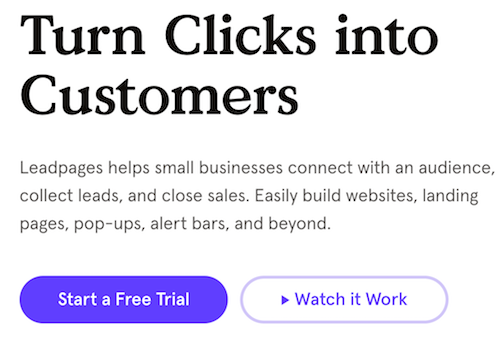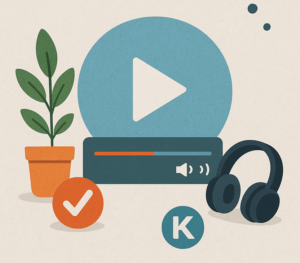
How to Set Up Email Marketing in Kartra
Email marketing means sending a single email to many people. It’s great for updates, offers, and building a loyal audience.In simple words, it’s talking to
Whether you are just starting your business or you already have a business, I’m sure you will agree that customers are important.
Of course, they are, right?
Unfortunately, the first time a person is introduced to your business may not be when they choose to buy from you.
Similar to dating, you don’t just jump into a relationship. A customer wants to get to know your business first.
They may begin as a visitor and then become a lead.
A lead is anyone who may be interested in the product or service you offer. Often, they need to learn more about your business and the product or service you offer before they make a decision.
This is where lead pages come in. Just because someone doesn’t choose to become a customer today doesn’t mean they won’t become a customer in the future.
In fact, many people become customers by first becoming leads. Therefore, more leads equal more sales. It’s basically “Business 101.”
Unfortunately, only a small percentage of site visitors actually become leads. While there are dozens upon dozens of reasons why a visitor may leave your site prior to becoming a lead, one of the largest reasons for this is an ineffective lead page, or worse yet, not having one at all.
Also called lead capture pages, lead pages are a must for any modern business, marketer, or entrepreneur.
So, what are lead pages? Better yet, how do you create effective lead pages that reel in customers left and right?
That’s what you are here to learn all about!
Today, we’ll delve deep into the power of lead pages and discuss…
Keep reading to learn all about lead pages and how to build your very own powerful lead pages to generate more leads, customers, and sales starting today!
First things first…
What is a lead page?
A lead or lead capture page (or even lead generation page) is a type of website page that is optimized with a lead capture form. The form gives you the ability to collect leads for your specific product, service, or offer and nurture them through every step of your marketing funnel.
As such, lead pages can play an integral role in your business. They will allow you to collect the valuable contact information of potential customers, giving you the opportunity to nurture and market to them time and again.
In this regard, lead pages are similar to darts. If you keep throwing darts at the board, you’ll eventually hit a bullseye.
Lead pages will help you strengthen your relationships with target customers, build trust, and ultimately, make more sales.
To do so, lead pages are inherently different from the other pages on a website. They are standalone post-click pages created to do one thing: collect visitor information to generate leads.
While a home page is usually created to showcase products and educate potential customers about your brand, lead pages have a much narrower focus. Therefore, there’s no need for navigation links.
The main goal of lead pages is simply to convert visitors into leads by encouraging them to enter their information into a form.
Your site can only have one homepage, but it can have dozens of lead pages targeting different customers and promotions.
Why? Because the more lead pages you have, the more leads you will generate.
In fact, according to data gathered by Impact, companies who utilize 40 or more lead pages generate more than 12 times the number of leads as companies with fewer than five.
It really is a numbers game. However, the effectiveness of a capture page can also play a huge role in lead generation.
The number of lead pages in your marketing arsenal will only boost lead generation if they are effective and of high quality.
We’ll discuss the fundamentals of effective capture page creation in a bit, but first, let’s get rid of any confusion by talking a little about the differences between lead capture pages and landing pages.
People often confuse landing pages with lead pages and vice versa. However, while there are definitely similarities between the two, there are some important differences as well.
From SaaS trial signups to ebooks and whitepaper downloads, a landing page is a webpage designed to execute any number of conversion goals. Lead pages, on the other hand, have a single goal – to collect visitor names and email addresses. The only purpose is to collect leads.
To do so, lead pages typically present visitors with an offer. Whether it’s a free ebook, white paper, coupon, or anything else, the goal remains the same – to collect the names and email addresses of visitors.
Some lead pages can be landing pages, but not all landing pages are lead pages, because different landing pages often have very different goals. As the purpose of a lead and landing page can be different, the page elements of each are also different.
While landing pages may contain a lengthy presentation or information to educate visitors about a product or service, lead pages are shorter, much more direct, and have fewer distractions because they each have a constant conversion goal.
With fewer distractions, visitors are able to focus on the offer and completing the form, resulting in more leads. There’s no links, navigation, and almost zero options other than giving their personal contact information and becoming a lead.

 Picture from Leadpages
Picture from LeadpagesAlthough landing and lead pages can both play an important role in any modern marketing campaign and each are similar in a number of ways, they are also very different. Ultimately, your objective should determine which one you use.
If you have a broad, multi-faceted conversion funnel or want to make an immediate sale right on the same page, you may want to go with a landing page. On the other hand, if your primary goal is lead generation for both short and long-term marketing and sales opportunities, a lead capture page will usually work best.
Regardless of which type of page you opt for, LeadPages can help you easily create both. With endless highly converting, attention-grabbing templates to choose from, one-touch technology, and push-button publishing, it’s quite simply one of today’s best lead and landing page creation tools.
 Picture from Leadpages
Picture from LeadpagesWhen building a lead capture page, you can go the expensive route and hire a Web designer or create the page yourself using dynamic and intuitive landing page software like Leadpages.
Hiring a designer can be quite expensive. With A/B testing and the need to test several pages in order to maximize conversion rates, the bill can quickly add up. Plus, many designers lack marketing savvy and skills, so managing their performance can prove difficult and time-consuming.
Thanks to Leadpages, however, you can build and publish your very own lead pages in a matter of minutes. Not only do they offer a full range of dynamic, proven-to-convert templates to choose from, but you can easily edit and customize pages, select from a variety of integrations, and publish each one with a few taps on a pad or clicks of the mouse.
When using Leadpages to build your lead capture pages, you will also be able to connect each form to your autoresponder service. Leadpages integrates with dozens of marketing tools and continues to add more, so whether you use Aweber, Constant Contact, or any number of autoresponder services, you can begin collecting an endless flow of leads in no time at all.
With Leadpages, you can create and connect your lead pages with your favorite marketing tools in just a few simple and easy clicks. Best of all, you can try out Leadpages for free for 14 days. That’s right; they offer a free two-week trial in order to give everyone ample time to test drive their platform. Pretty cool, right?

That being said, Leadpages can’t do everything for you. You will still need to decide on the look, feel, and content of your lead capture pages.
Want to turn a trickle of leads into a tsunami? Here some helpful tips:
It’s important to position your lead pages where people will see it. Many marketers make the mistake of placing their lead pages below the fold of a page, or worse yet, at the bottom.
Unfortunately, most visitors don’t make it this far. Therefore, it’s best to create a native ad near the header and link from there. Better still, have it pop up on the page, this way it will be impossible to miss.
If you do go the pop-up route, however, just make sure not to introduce your lead pages too soon. This can be disruptive and actually turn away visitors. Instead, give them some time to view your site and have your lead pages appear when they’re about to leave rather than browsing.
A quality headline can make all the difference when trying to capture the attention of visitors. They need to know what they’re looking at and be explicitly led into lead pages. If not, they’ll quickly click away.
There are several different ways to craft captivating marketing headlines for lead capture forms. Nonetheless, when creating lead capture headlines, it’s best to get straight to the point, be specific, and tell visitors exactly what you’re offering.
When creating a lead capture form, you should determine its specific goal and exactly what you want the campaign to achieve. If you simply want to generate as many leads as possible, a short lead capture form may be best. However, if you want better quality leads, a longer form is definitely the way to go.
If a visitor is willing to put in the effort to fill in more fields, the chance of them making a purchase is much higher. This gives them a higher customer acquisition and value, which can affect the way you market to them in the future.
That said since sales can sometimes be a numbers game, you need to balance lead quality and lead volume. It’s best to find the “sweet spot” or just the right number of fields to generate a high volume of leads without sacrificing lead quality.
Trust is a huge issue for many online shoppers. Online, businesses are basically faceless. So, if someone has never heard of you, why would they give you their name and contact details?
Unfortunately, since many online retailers and other businesses fail to deliver on their promises, earning trust is even more difficult. To overcome this common dilemma, make sure to provide plenty of evidence supporting whatever claims you make.
Since authority breeds trust, it’s equally important to position yourself as an expert in your industry or field. Doing so will earn the trust of visitors and generate more leads.
Unless they have an immediate genuine intent to make a purchase, visitors are more likely to give their personal details if they’re incentivized to do so with an offer they can’t refuse.
Why? The answer is simple: most people have a hard time turning down anything free. By offering a free trial or gift, you’re able to tap into this common psychological characteristic and use it to your advantage by collecting a lead.
By offering the incentive of a free gift or trial, you’re also able to ask for more information. This means you’ll receive higher quality leads, resulting in more conversions.
Just remember, if you’re offering a free gift, it should be relevant and something visitors will actually want. The good news is this is easy to do. From promotional gifts designed to raise brand awareness to ebooks or whitepapers related to the search term a visitor used to make their way to your landing page, you should be able to come up with several quality freebie ideas.
Want more great tips for creating awesome, high-converting lead pages? Check out the Leadpages blog and weekly webinar for a mountain of invaluable information covering everything lead-related.
Whether you sell yachts, life insurance, supplements, or coaching and information, generating a sufficient number of high-quality leads can be a difficult quest. The truth is the vast majority of people who visit your site won’t make it past the first page, let alone take any extra steps to engage and connect with your brand.
However, you can certainly give them a nudge. By utilizing powerful lead generation software like Leadpages and putting in the effort to create dynamic lead pages that attract and engage with visitors, you’ll be able to supercharge your lead collection and sales efforts.
Do new customers come out of thin air? Of course not, but with the right lead page and marketing funnel, it can certainly seem that way.
Digital marketing is a science, not some mystical art. With the right know-how and tools, you can create an endless flow of fresh, high-quality leads to market to time and time again.
With Leadpages, you’ll have access to a multitude of resources and tools to take your lead generation to the next level and engage with your audience like never before.

Email marketing means sending a single email to many people. It’s great for updates, offers, and building a loyal audience.In simple words, it’s talking to

Leadpages is a tool that helps build landing pages fast and easy. You don’t need coding or design skills to create something great. Just pick

Kartra Video Hosting lets you upload and manage videos easily. It’s a smart online video tool for sharing content with your audience. You don’t need
Copyright 2021 Dwayne Graves Online | All Rights Reserved |